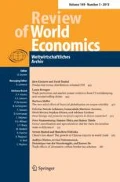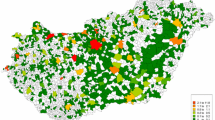Abstract
A key feature of the Swedish economy over the last two decades has been the rapid internationalisation of its economy, both through FDI and exports. In this paper we consider their inter-relationship, examining whether there have been spillovers from foreign firms to the export performance of domestic firms. We also contribute to the empirical modelling of export spillovers. We do this by exploiting information on whether foreign MNE sales are intra-firm or inter-firm, and by allowing for heterogeneity in the characteristics of the sender and receiver of spillovers. Our results indicate that foreign MNEs had positive effects on Swedish exports.
Similar content being viewed by others
Notes
The previous studies on Sweden use the same data as in the present paper.
See Swedish Government Official Report (2008, 90) for a further discussion of this point.
Nothing in the above argument about demonstration or congestion is specific to the presence of foreign multinational firms. Larger numbers of domestic or foreign-owned firms that export will likely crowd out scarce resources in a similar manner, or equally offer opportunities for imitation. In such a case we might then expect no difference in the effect of foreign compared to domestic multinational firms, i.e. from large firms. We explored this by replacing foreign with domestic (Swedish) multinational firms in the regression. Unfortunately, this extension of the analysis leads us no further since none of the MNE presence coefficients were significant. Those estimates are not reported but can be ordered from the authors upon request.
The two-step methodology involves estimating first the probit of the export decision (i.e. selection equation), computing the inverse of the Mills ratio and inserting it as regressor in the export share regression.
Hansson et al. (2007) report summary statistics that show how the share of exporters in Swedish manufacturing is distributed over different size classes.
We use votes rather than shares, since Swedish firms may, and do, issue shares with widely different voting power. Obviously the issue of foreign control is not so simple that it can be completely described by a binary variable switching from 0 to 1 at a certain level of voting power, here 50 per cent, since—depending on the ownership structure—a share of the votes much lower than that may be sufficient to give a high degree of control.
The eliminated firms are distributed unevenly between the 22 industries at the two digit level: Machinery, equipment (17%), Fabricated metal (11%), Food & beverages (9%), Wood (8%), Motor vehicles (8%), Paper & pulp (7%), Medical instruments (6%), Chemicals (6%), Non-metallic mineral (5%), Rubber & plastic (4%), Publishing, printing (4%), Basic metals (3%), Other manufacturing (3%), Electrical machinery (3%), Other transport eq. (2%), Radio TV (2%), Textiles (1%), Electrical & optical (1%).
For a more detailed comparison of studies within this literature see Greenaway and Kneller (2007).
The response rate in the manufacturing sector was very high. For firms with more than 50 employees the response rate is over 95%. After 2001 the survey was less ambitious in scope and therefore marks the end of the data period we use in the study. Comparing these data with a different series on firm exports (which does not separate between intra-firm and inter-firm exports) also collected by Statistics Sweden, we find a correlation (for the years 1997–2005) of export values of over 93%. The correlation in terms of number of exporters is a few percentage points lower since the data where intra-firm and inter-firm exports are collected at a higher level in the enterprise.
Given the use of both industry and firm level variables in the regression we estimate all specifications using the Moulton--White standard errors adjusted to account for possible correlation within a cluster (Moulton 1990).
The term horizontal spillovers refers to within industry spillovers. Spillovers may also follow input–output flows, upstream—from a foreign-owned customer to a domestic seller—and downstream (backward and forward linkages). See, e.g. Griliches (1992, 1995) on the issue of input–output flows and knowledge spillovers. These between industry spillovers may be tracked by using input–output tables. This is, however, beyond the scope of this paper.
As around two-thirds of firms report no R&D, we follow Grünfeld (2003) and set these values to zero.
We also follow standard practice in using lagged foreign presence measures.
TFP is measured using the Törnqvist Index approach.
By including both firm level R&D and skill intensity we would introduce a double counting problem, since a substantial part of the R&D expenditures are wages to high-skilled employees. The other obvious option would be to adjust firm level R&D intensity to consider this double counting problem. Not reported, but with qualitatively similar results are specifications using skill intensity instead of R&D intensities.
As an alternative to 4-digit industry effects we also attempted to control for differences in the propensity to export across industries and for changes in difficult-to-measure factors that have changed across time, such as trade costs, by including a measure of the industry export share. This variable is constructed at the 2-digit level. Our estimates are robust to the inclusion of this variable and can be ordered from the authors upon request.
The producer price index shows the average change in prices at producer and import stages for different industries and product groups, i.e. in the first distribution stage when goods are delivered from Swedish producers or come into Sweden.
In the present specification competition effects of foreign presence cannot be captured as all parameters are identified conditional on firm productivity. One way to deal with this issue would be to re-estimate the model without continuous TFP and size, but with pre-sample TFP and employment as control variables instead. To investigate whether this had any effect on our results we tried an additional specification using initial TFP and initial size instead of TFP and size as a continuous variables. The results are robust to this approach as the significance and magnitude of the relevant parameter estimates remained almost unchanged.
In relation to the discussion of the type of FDI, the evidence in Table 7 suggests that these new measures of foreign presence give more weight to single-plant rather than multi-plant firms. Table 7 suggests that multi-plant firms are much larger than single-plant firms, whereas the TFP gap, while still positive, is proportionately smaller on average.
As an alternative measure of absorptive capacity we used the skill intensity. The interaction of skill intensity, measured by the proportion of the labour force with post secondary education, gives similar results.
References
Aitken, B., Hanson, G. H., & Harrison, A. E. (1997). Spillovers, foreign investment, and export behavior. Journal of International Economics, 43(1–2), 103–132.
Aitken, B. J., & Harrison, A. E. (1999). Do domestic firms benefit from direct foreign investment? Evidence from Venezuela. American Economic Review, 89(3), 605–618.
Aw, B.-Y., Roberts, M. J., & Winston, T. (2007). Export market participation, investments in R&D and worker training, and the evolution of firm productivity. The World Economy, 30(1), 83–104.
Barrios, S., Görg, H., & Strobl, E. (2003). Explaining firms’ export behaviour: R&D, spillovers and the destination market. Oxford Bulletin of Economics and Statistics, 65(4), 475–496.
Bernard, A., & Jensen, J. B. (1999). Exceptional exporters performance: Cause, effect or both? Journal of International Economics, 47(1), 1–25.
Bernard, A., & Jensen, J. B. (2004). Why some firms export. Review of Economics and Statistics, 86(2), 561–569.
Blomström, M., & Kokko, A. (2003). The economics of foreign direct investment incentives (NBER Working Paper no. 9489).
Cohen, W., & Levinthal, D. (1989). Innovation and learning: The two faces of R&D. Economic Journal, 99(397), 569–596.
Findlay, R. (1978). Relative backwardness, direct foreign investment and the transfer of technology: A simple dynamic model. Quarterly Journal of Economics, 92(1), 1–16.
Girma, S., Greenaway, D., & Kneller, R. (2004). Does exporting lead to better performance? A microeconometric analysis of matched firms. Review of International Economics, 12(5), 855–866.
Girma, S., & Wakelin, K. (2002). Are there regional spillovers from FDI in the UK? In D. Greenaway, R. Upward, & K. Wakelin (Eds.), Trade, investment, migration and labour markets (pp. 172–186). Basingstoke: Macmillan.
Görg, H., & Greenaway, D. (2004). Much ado about nothing? Do domestic firms really benefit from foreign direct investment? World Bank Research Observer, 19(2), 171–197.
Greenaway, D., Gullstrand, J., & Kneller, R. (2006). Exporting may not always boost firm level productivity. Review of World Economics/Weltwirschaftliches Archiv, 141(4), 561–582.
Greenaway, D., & Kneller, R. (2007). Firm heterogeneity, exports and FDI. Economic Journal, 117 , 134–161.
Greenaway, D., & Kneller, R. (2008). Exporting, productivity and agglomeration. European Economic Review, 52 (5), 919–939.
Greenaway, D., Sousa, N., & Wakelin, K. (2004). Do domestic firms learn to export from multinationals? European Journal of Political Economy, 20 (4), 1027–1043.
Griliches, Z. (1992). The search for R&D spillovers. Scandinavian Journal of Economics, 94 (Suppl), 29–47.
Griliches, Z. (1995). R&D and productivity: Econometric results and measurement issues. In P. Stoneman (Ed.), Handbook of the economics of innovation and technical change (pp. 52–89). Oxford: Basil Blackwell.
Grünfeld, L. A. (2003). Meet me halfway but don’t rush—Absorptive capacity and strategic R&D investment revisited. International Journal of Industrial Organization, 21(8), 1091–1109.
Hansson, P., Karpaty, P., Lindvert, M., Lundberg, L., Poldahl, P., & Yun, L. (2007). Swedish business sector in a globalized world—Impact of internationalization on productivity and employment, ITPS 2007:004. Östersund: Swedish Institute for Growth Policy Studies.
Haskel, J. E., Pereira, S. C., & Slaughter, M. J. (2002). Does inward foreign direct investment boost the productivity of domestic firms? (NBER Working Papers 8724).
Heckman, J. J. (1979). Sample selection bias as a specification error. Econometrica, 47(1), 153–161.
Helpman, E., Melitz, M., & Rubinstein, Y. (2008). Estimating trade flows: Trading partners and trading volumes. Quarterly Journal of Economics, 123(2), 441–487.
Javorcik, B. S. (2004). Does foreign direct investment increase the productivity of domestic firms? In search of spillovers through backward linkages. American Economic Review, 94(3), 605–627.
Kneller, R., & Pisu, M. (2007). Industrial linkages and export spillovers from FDI. The World Economy, 30(1), 105–134.
Kokko, A., Tansini, R., & Zejan, M. C. (1996). Local technological capability and productivity spillovers from FDI in the Uruguayan manufacturing sector. Journal of Development Studies, 32(4), 602–611.
Kokko, A., Tansini, R., & Zejan, M. C. (2001). Trade regimes and spillover effects of FDI: Evidence from Uruguay. Weltwirtschaftliches Archiv/Review of World Economics, 137(1), 124–149.
Melitz, M. J. (2003). The impact of trade on intra-industry reallocations and aggregate industry productivity. Econometrica, 71(6), 1695–1725.
Moulton, B. R. (1990). An illustration of a pitfall in estimating the effects of aggregate variables on micro unit. The Review of Economics and Statistics, 72(2), 334–338.
Roberts, M. J., & Tybout, J. R. (1997). The decision to export in Colombia: An empirical model of entry with sunk costs. American Economic Review, 87(4), 545–564.
Ruane, F., & Sutherland, J. (2005). Foreign direct investment and export spillovers: How do export platforms fare? (IIIS Discussion Paper No.58).
Sjöholm, F. (2003). Which Indonesian firms export? The importance of foreign networks. Papers in Regional Science, 82(3), 333–350.
Swedish Government Official Report. (2008). Svensk export och internationalisering Utveckling, utmaningar, företagsklimat och främjande. Stockholm: Fritzes.
Swenson, D. L. (2008). Multinationals and the creation of Chinese trade linkages. Canadian Journal of Economics, 41(2), 596–618.
Wagner, J. (2007). Productivity and size of the export market: Evidence for West and East German plants, 2004 (IZA Discussion Paper no. 2661).
Acknowledgments
Richard Kneller gratefully acknowledges financial support from the Leverhulme Trust (Grant No. F114/BF) and Patrik Karpaty acknowledges financial support from the Jan Wallander and Tom Hedelius Foundation.
Author information
Authors and Affiliations
Corresponding author
Appendix
Appendix
See Table 7.
About this article
Cite this article
Karpaty, P., Kneller, R. Demonstration or congestion? Export spillovers in Sweden. Rev World Econ 147, 109–130 (2011). https://doi.org/10.1007/s10290-010-0075-5
Published:
Issue Date:
DOI: https://doi.org/10.1007/s10290-010-0075-5



